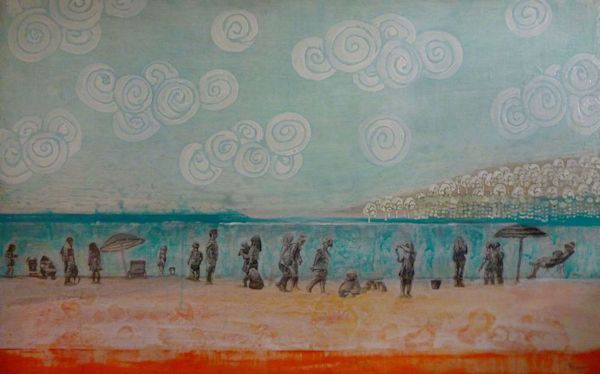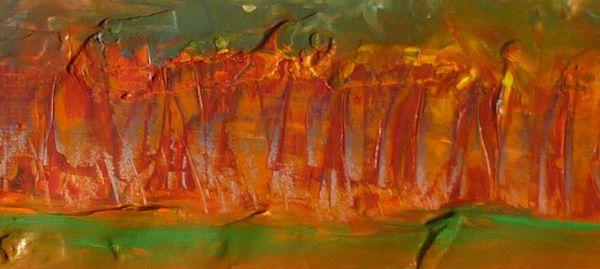As an artist, the world is your medium. Any substance can be used and modified to create a work of fine art because art is ever-changing. The same is true with traditional mediums, like acrylic paint.
Mediums for acrylic painting make this already adaptable paint even more dynamic. With medium, you can modify acrylic paint properties like thickness, shine, drying time, and texture. This overview will help you get a better sense of the most frequently used mediums for manipulating acrylic paint.

Painting via Craftsy instructor Bennett Vadnais
Here’s an overview of mediums for acrylic paint
1. Gel medium
It is possible to dilute acrylic paint with water, but I wouldn’t advise it. After a certain ratio of water to paint (usually around 1:1), the paint will loose its adherence properties, causing uneven coverage. Adding gel medium to the paint is a way to increase the paint’s transparency without compromising the consistency and adhesive properties. Gel medium will have a unique effect on the consistency, finish and adhesive.

White Rock by Sandrine Pelissier
Note: In the above painting, entitled “White Rock,” areas of translucent orange and blue paint have been painted with acrylic paint and gel medium in order to achieve a translucent look.
Gel medium: consistency
Gel medium comes in different consistencies from liquid to heavy body.
- Liquid gel medium will increase the paint fluidity: Liquid gel will increase fluidity and transparency of acrylic paint, so brushstrokes will be less visible. It can be used to decrease the color intensity of acrylic paint. Usually, liquid gels are self-leveling, making them convenient for glazing. Glazing allows you to add a thin and transparent layer of paint, slightly modifying the color underneath. You can also buy glazing medium made specifically for this effect, which are helpful for everything from painting flowers and landscapes to painting portraits in acrylics.
- Heavy body medium will increase the paint consistency: Heavier body medium will add body to the paint, thus making brushstrokes more visible. Heavy body medium is very well suited for impasto painting techniques.
Gel medium: finish
Gel medium comes in matte, semi-gloss or gloss finish. The finish alters the paint’s level of shine. If your completed painting has an uneven finish, with some areas glossier than others, using a medium varnish finish will correct this issue, resulting in uniform shine.
Gel medium: adhesive
Most gel mediums can be used as adhesive, which works well for collaging papers or other elements on your painting. When collaging, I would choose a gel medium with a gloss finish as opposed to a matte finish in order to render the best result.

Here, gel medium can be used as an adhesive to fix some thread on an acrylic painting.

Gel medium can also be used for collaging paper on an acrylic painting as it is here, in the first steps of a mixed media piece.
2. Texture mediums
Texture mediums are used to modify the texture of acrylic paint. Many brands carry a wide variety of texture mediums: modeling gel, sand texture gel, beads texture gel, pumice, glass texture gel and so much more.
Texture mediums: modeling paste
Modeling paste is the most commonly used texture medium. This opaque-white heavy gel is usually made of marble paste and will adhere over most surfaces. It can be used to create 3-D textures. Once dried, modeling paste can be sanded and/or painted over.

Modeling paste can be painted over once dried, as seen above.
Texture medium: acrylic ground for pastels
Applying a medium with fine texture, like acrylic ground, allows pastels to be painted on canvas for a painting or for a mixed-media piece.

In the above piece, the background was painted in acrylic and the pears were painted with pastels over acrylic ground pastel medium.
3. Flow increase medium
You can buy medium that will increase the flow of acrylic paint. Increased flow makes the paint easily adhere to the canvas’s texture, increasing its staining properties. It can also be used for pouring techniques. Essentially, flow medium will increase the staining properties of your acrylic.

Les cabines de la plage en Bretagne via Craftsy blogger Sandrine Pelissier
4. Slow drying medium
Acrylic paint drys very fast, making it difficult to blend colors on the canvas. Adding slow drying medium to the paint will double the drying time, causing the acrylic to behave a bit more like oil paint and allowing you time to blend colors.
<!–
20+ Essential Acrylic Techniques
Add inspiring richness and professional quality to your paintings as you plumb the depths of modern acrylic mediums.

what ratio or flow medium to paint (liquid) do I need tp do a pouring technique?